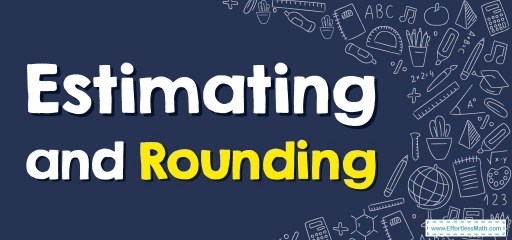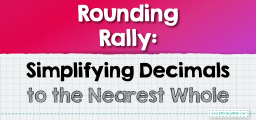Estimating and Rounding
If you want to know more about how to estimate and round numbers, do not miss our article about it!

Estimating and rounding are mathematics tactics utilized for estimating a number. To estimate means you are making a rough guesstimate or a calculation.
If you are rounding, it means you want to simplify a recognized number by scaling it somewhat up or down. So, rounding is a kind of estimation. Both techniques can aid one in making educated guesses and you can use them in regular life for tasks linked to cash, distance, or time.
Related Topics
Way to Round Numbers
Rounding involves reducing the number of digits within a number yet ensuring the number stays near the original amount. These potential figures have zeros within the digits on the right (they’re multiples of \(10\)). To round a numeral, you must use the following steps:
Step one: Locate the “round off” number. The round-off number is the place value of the figure you want to round up or down to. For instance, if you wish to round a figure to the closest ten, the round-off number is the one located in the tens’ place. If you wish to round it to the closest hundred, the round-off number is the number seen in the hundreds’ position.
Step two: Look to the number on the right of the rounding number. If it is \(5\) or more, take the rounding number up to one digit. If this is lower than \(5\), take it down one digit.
Step three: Change every number on the right of the rounded-off digit to \(0\)s.
Note: Whenever a figure is halfway in between the \(2\) likely figures, round it up to the larger figure.
Estimating and Rounding – Example 1:
Estimate the sum by rounding a number to the nearest ten.
\(32+87=\)
Solution:
First-round the numbers to the nearest ten. Look to the number on the right of the rounding number. The number on the right of \(32\) is \(2\). This is lower than \(5\), so, round down. It will be \(30\).
The number on the right of \(87\) is \(7\). This is more than \(5\), so, round it up. It will be \(90\).
Now add the two numbers together \(= 30+90=120\)
Estimating and Rounding – Example 2:
Estimate the product by rounding a number to the nearest ten.
\(11 × 26=\)
Solution:
First-round the numbers to the nearest ten. Look to the number on the right of the rounding number. The number on the right of \(11\) is \(1\). This is lower than \(5\), so, round down. It will be \(10\).
The number on the right of \(26\) is \(6\). This is more than \(5\), so, round it up. It will be \(30\).
Now multiply the two numbers together \(= 10 × 20=200\)
Exercises for Estimating and Rounding
Estimate the sum or product by rounding each number to the nearest ten.
- \(\color{blue}{35+51=}\)
- \(\color{blue}{23+44=}\)
- \(\color{blue}{13×19=}\)
- \(\color{blue}{67×34=}\)

- \(\color{blue}{90}\)
- \(\color{blue}{60}\)
- \(\color{blue}{200}\)
- \(\color{blue}{2,100}\)
Related to This Article
More math articles
- Best Laptops for Middle School Students
- Algebra Puzzle – Challenge 57
- How to Use Lattice Multiplication Method
- How To Check Your Work During Math Exams?
- Your Math Buddy: How to Unravel the Mystery of Mutually Exclusive and Overlapping Probabilities
- FREE 5th Grade FSA Math Practice Test
- How to Decide Between the ACT and SAT?
- How to Use the Law of Cosines to Find Angle Measure?
- Bеѕt Cаlсulаtоr fоr ACT Aspire Mаth Tеѕt
- How to Prepare for the Next-Generation ACCUPLACER Math Test?

















What people say about "Estimating and Rounding - Effortless Math: We Help Students Learn to LOVE Mathematics"?
No one replied yet.